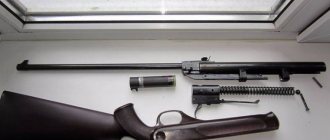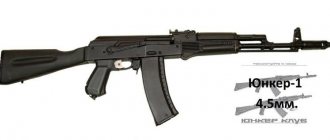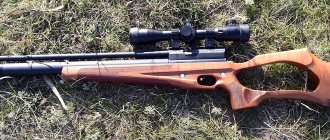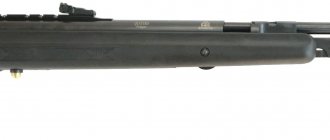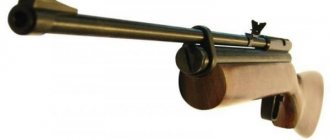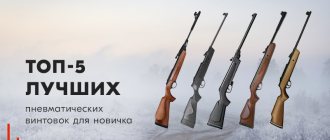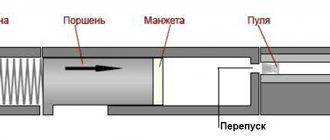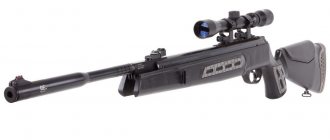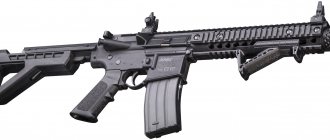Review of Anschutz air rifles
Full company name JG ANSCHÜTZ GmbH & Co. KG is a German manufacturer located in the city of Zella-Mellis, and the plant was founded back in 1856 on the basis of a repair shop. The first weapons produced were pistols chambered for Flaubert, pocket and muzzle-loading models, as well as hunting rifles. Later in the 30s, the company began producing air guns for training soldiers.
Before the start, as well as directly during the Second World War, the company received a serious impetus for development, but after the defeat of Germany, the plant was closed. The manufacturer was revived in 1950 and began producing high-quality, high-precision air rifles and pistols for hunters and athletes. The company placed the main emphasis on thoughtfulness in detail, precise fit of parts, as well as on the high quality of the materials themselves.
1985 can also be considered significant for the company, as a rifle for biathlon was released. It had a wooden stock and an adjustable butt. Its main advantage was the bolt, which made it possible to almost instantly reload the weapon with just one finger, without completely removing your hand from the pistol grip.
Let's take a closer look at the features of the rifles produced by the company.
Versatile athlete. Air rifle Anschutz 9015
The Anschutz 9015 bolt group is based on the renowned 9003 Premium bolt group. Optimized parameters of the compressed air dosing system, a casing and muzzle made of high-quality steel, as well as an adjustable match trigger are the distinctive features of the model. The firing pin and valves have been modified to avoid shock when firing a shot. The cocking lever can be placed on either the right or left to suit the tastes of any shooter in any discipline.
The Anschutz 9015 One rifle provides shooters with a wide variety of adjustment options.
The mechanical match trigger 5065 4K with ball bearings is particularly convincing thanks to its exceptionally fast release. According to Anschutz, the shot is fired even slightly faster than with electronic triggers. The axial ball bearing support with four balls (4K) ensures complete absence of play in the trigger mount. The shooter can set the trigger force in the range from 30 to 170 g, the factory setting is 100 g. The trigger can be adjusted by a total of 22 mm in length.
For the 9015 One, Anschuetz designed its own escapement. The patented escapement, designated 5065 4K, is mechanical and suspended on four ball bearings (highlighted in yellow in the drawing)
Yet the new bolt group did not have a corresponding stock. The task set by Anschutz was a multifunctional stock design that could be used in all air rifle disciplines and in any configuration. At the same time, we could not forget about the shooters who practice shooting from a point-blank range. The name One says it all: the new Anschutz stock design was to be the first of its kind on the market. The name also means contact with the body only where the shooter really needs it. In addition, the stock “grows” under the shooter due to the movement of the butt cheek, and thus it can be used by both juniors and adult shooters, no matter whether they are right- or left-handed. The walnut cheek piece can be infinitely adjusted in any direction. The butt plate of its own design not only has a futuristic appearance, but is equipped with adjustable elements and weights, giving the shooter the opportunity to customize it without restrictions in any direction. Due to the additional rod, the buttstock maintains constant contact with the shooter’s chest. The height of the butt with the help of a quick-release lock can be adjusted in parallel. The butt plate of the butt remains in the same position. Additionally, the shooter can use the screw to arbitrarily move the butt to the right or left.
The One model's buttplate design is completely different. The shooter can make adjustments in all linear and angular directions
The pistol grip, also made of walnut wood, has a groove on the inside. This allows you to keep the rifle closer to the body. Walnut wood is also used in the height-adjustable part of the forend. The arm support is infinitely adjustable in height. The scale, graduated in white, shows the distance of the hand support from the axis of the bore. Moreover, you can move the support along the fore-end and rotate it depending on whether you prefer a rifle with an advantage in the muzzle or a balanced match rifle, thereby achieving the necessary stability of the weapon in the shooter's hand. The handguard is made of carbon fiber and covers a compressed air cylinder. Additional weights (100 g) can also be placed there; additional places for steel weights are available under the barrel (50 g), as well as on the barrel casing (80 g). By moving the casing, you can select any length of the barrel group. In addition, due to the prism on the underside of the receiver casing, it is possible to install a bracket for the SCATT training module. Thanks to this, the shooter can use a smartphone or laptop to determine the behavior of the rifle before, during and after the shot. The Model 9015 is available in grip sizes S, M and L. For rest shooters, the Model 9015 is also available with a One stock. The overall length of the Anschuetz rifle ranges from 99 to 120 cm, the barrel length is 64 cm. The length of the sighting line varies from 62 to 89.7 cm. The rifle weighs 4.6 kg, which meets the standards for air match rifles. For the 9015, Anschutz also offers a Precise stock made of high-strength aluminum.
The Anschutz 9015 Precis stock is more massive than the One, but also allows for a variety of adjustments
If you look closely at the stock in the longitudinal direction, you will notice its wedge-shaped shape. This results in smaller fluctuations and higher accuracy potential than previously achieved. The walnut pistol grip gives a pleasant grip feel. The individually adjustable stock also provides comfort to the shooter. It can rotate around its longitudinal axis, so it can be adjusted to suit shooters with a wide variety of constitutions.
The butt of the Precise stock allows rotation around the longitudinal axis
An all-new buttplate with various adjustment elements promotes better shoulder contact. As standard, Anschuetz produces the Precise stock with a raised forend that can be infinitely adjusted in height and length. For optimal grip of the rifle, the forend can also be rotated horizontally. In addition, the Precise stock is modular, which allows you to replace the stock in just a few operations or, accordingly, disassemble it for transportation in a small case.
Natalie Kemmelmeier, translation by Ilya Shaidurov
The lineup
8002 S2
This is an air sporting rifle that operates with pre-injection air or PCP. Such a weapon is good because it is capable of providing high pressure and maximum speed of ammunition with excellent accuracy of fire, as well as high reliability of the mechanism itself.
The body is made of anodized aluminum, and the cheekpiece, forend and pistol grip are specially textured to prevent slipping during shooting.
Photo of the Anschutz 8002 S2 sports air rifle
9003
Also a pre-pumped sporting rifle. It mainly differs from the previous version in slightly lighter weight and a modified frame. The stock and cheekpiece can be adjusted over a wider range, allowing the weapon to be perfectly tailored to any athlete.
Photo of Anschutz 9003 air rifle
2002
This is also a pre-injected rifle, but the process itself is quite interesting, since on the right side there is a lever, due to the movement of which the pressure increases. In order to make the task easier for the shooter, a lever system and a gas spring were installed, thanks to which it was possible to reduce the load to 7.5 kg. Also interesting is the shutter itself, the lever of which has a very short stroke and allows you to install fairly large optics without significant modifications.
Photo of Anschutz 2002 air rifle
"Anschutz - Fortner" 1827F, or a quarter of a century of the great biathlon revolution (anschutz rifles)
From military-applied to mass sport. Until the mid-70s, biathlon was considered a military applied sport. The shooting skiers used weapons based primarily on military repeating rifles with a powerful rifle cartridge. The distance was also significant: from 150 to 200 m. Such a distance of targets from the firing line made it necessary to build expensive shooting ranges and made it difficult for spectators to observe the results of shooting - the most interesting moment of biathlon competitions. The biathletes themselves were not happy with the weapons either. Izhevsk gunsmiths were the first to make an attempt to switch to weapons of a smaller caliber, releasing the BI-6, 5 rifle of 6, 5 mm caliber back in 1964 with a slightly lower recoil force. In 1971, the BIL-6, 5 model appeared, which no longer used the Mosin rifle as a base, but the Los hunting carbine. A year earlier, at Izhmash, for young biathletes, based on the SM-2 sports rifle, the BI-4 was designed for a small-caliber cartridge of 5.6 mm caliber. The idea of Izhevsk residents interested German biathletes, and in 1975 the Bundeswehr approached with a proposal to create a new biathlon rifle, with which the German team planned to compete at the Winter Olympics in Innsbruck. In previous models, German athletes were not satisfied with the strong recoil, and therefore the rifle had to be designed for the low-pulse .222 centerfire cartridge. This is how a new weapon of .222 caliber arose, designed on the basis of the Anschutz 54 rifle, the best model of a small-caliber match rifle at that time. This was the beginning of her then boss Dieter Anschutz’s path to biathlon. Dieter Anschutz is a representative of the third generation of the Anschutz dynasty, which founded the family business in 1856. He had to begin his career as a gunsmith during a difficult period for the company after the end of the Second World War. There was no money for education, so he was sent to study at the Carl Zeiss plant in Jena. An internship at a world-famous optics manufacturing company played a decisive role in Dieter’s career. According to him, the knowledge in the field of precision mechanics obtained at Zeiss turned out to be very useful in the design of sporting weapons. After Dieter returned to the family business, Anschutz concentrated its efforts on the production of small-bore sporting rifles and achieved significant results. The above-mentioned model 54 becomes the undisputed leader among sporting rifles of the 50s and 60s and brings many medals of the highest standard to Anschutz’s collection. The Model 54 and its rifles opened up a wide path into biathlon for juniors and women. The sound of a small bore rifle is not as loud as that of a normal caliber rifle, so not only the shooters and spectators would benefit by switching to a small caliber, but also the residents of houses located in the area of the shooting ranges. But the most important consequence of such a transition would be the loss of biathlon’s reputation as a “militarized” sport. Dieter Anschutz did not hide his personal interest, because he was the head of a company that for many years successfully specialized in the production of small-caliber sporting rifles. This idea was supported by a number of reputable sports functionaries, such as Dr. Joseph Deflorian, who for a long time headed the Austrian shooting union, and Michael Possinger, a famous athlete and member of the presidium of the UIPMB (International Union of Modern Pentathlon and Biathlon). In February 1976, Dieter Anschutz and his wife Elfie traveled to Seefeld, Austria, for the 25th Congress of the Biathlon Union to present a simplified version of the Model 64, which later became the basis for numerous other Anschutz sporting and hunting weapons. Dieter Anschutz recalls that during the creation of the first biathlon rifle, he thought a lot about the further development of biathlon weapons and biathlon. As a result, I came to the firm conviction of the need to switch to weapons chambered for .221g. This could make biathlon less expensive, since the cost of a small-caliber cartridge is only 10% of the cost of a rifle cartridge. Significant savings would come from reducing the shooting distance from 150 to 50 m, which would make it possible to significantly reduce the amount of area required for the construction of biathlon stadiums. A short shooting distance would make the targets used in biathlon smaller and simpler, reducing their cost by about 80-90%. Less recoil and weight of the small-caliber version of the Anschutz 54 small-caliber rifle converted for biathlon and convincing the sports management of the need to switch to the .221g caliber. This task was very difficult. It was difficult to convince the members of the Soviet delegation, whose athletes, competing with large-caliber rifles, unconditionally dominated biathlon at that time. Therefore, Dieter had to resort to a little trick. Taking advantage of the fact that the congress participants lived in the same hotel, he visited all 20 delegations there and talked with their members, as they say, in an “informal” atmosphere. He had to make a lot of effort to explain all the advantages of switching to a small caliber. By the way, here Dieter Anschutz met the famous Soviet biathlete Alexander Tikhonov. The German entrepreneur still remembers him with great warmth and speaks very highly of him as an athlete and person. Dr. Joseph Deflorian, in his speech at the congress, has already officially outlined all the arguments for the transition of biathlon to small-caliber weapons. Under the leadership of Michael Possinger, the UIPMB technical committee prepared and submitted for consideration new rules for biathlon competitions, which provided for the use of .221g rifles chambered for rimfire. Possinger also proposed holding the 1978 Biathlon World Championships in Hochfilzen, Austria, in accordance with the changed rules. And yet, the vote (14 delegations were in favor and 8 were against) did not provide the two-thirds vote required to make a decision and jeopardized the adoption of new rules. The results of the voting did not suit Deflorian in any way, and he turned to the national federations with an ultimatum: either hold a repeat vote, or the 1978 World Championship will be postponed. After some pause for reflection, a new vote took place, which brought the necessary ratio of votes (17:5) to approve the rules. Thus, the .221g biathlon rifle was officially introduced into the UIPMB rules. This innovation radically transformed biathlon: the number of biathletes increased sharply, fans flowed like a river into biathlon stadiums, and shooting skier competitions became the highlight of sports television programs. For comparison, here are some numbers and facts. 85 biathletes from 19 countries took part in the 1976 Winter Olympics in Innsbruck. When the Biathlon Federation allowed women to participate in this sport, the first women's world championship was held in Chamonix, France, in 1984. It was attended by 37 athletes and 60 juniors from 16 countries. The development of youth biathlon received a significant impetus, since, thanks to the introduction of small-caliber weapons, the age threshold was reduced from 15 to 12 years. At the 1998 Olympics in Nagano, 30 countries were already represented at the biathlon competitions, for which 105 shooting skiers and 95 female skiers competed. At the last Winter Olympics in Turin, 90 biathletes from 37 countries and 84 female biathletes from 27 countries were entered. At the same time, 17 men's and 18 women's teams took part in the relay race. Competitors Initially, only the rotating bolt was allowed for biathlon small-bore rifles. This rule was introduced at the suggestion of Dieter Anschutz, then a member of the UIPMB technical commission. This made it possible to quickly create specialized weapons based on ordinary sporting rifles. Anschutz the prototype to 4.5 kg and the presence of a 5-round magazine. In addition, an exceptionally light striker was used with a working stroke reduced to 4 mm, providing a minimum, only 4 ms, shot production time: the time from the start of the trigger mechanism to the moment the bullet leaves the barrel. This time is important for biathletes, since shooting errors depend on it (the weapon is in constant motion when aiming and it is impossible to hold it absolutely still, therefore, due to the barrel moving away from the aiming line, it is important that the trigger mechanism works as quickly as possible) . The design and principle of operation of the bolt remained the same: to unlock it, it was necessary to turn the bolt handle and pull the bolt back to eject the spent cartridge case. After this, it was necessary to return the bolt forward to chamber the cartridge from the magazine into the chamber and turn the bolt handle to lock the barrel bore. The biathlete spent a relatively large amount of time on these movements - but it was impossible to reduce it, such a design was prescribed by the rules. However, very soon this restriction was lifted and in countries that held leading positions in biathlon sports, work began on creating special rifles with accelerated reloading. The Finns were among the first to experiment, introducing a hinge-lever mechanism on their rifle with cocking using a crank lever, similar to early small arms systems, such as the Parabellum P08 pistol or the Maxim machine gun. This rifle was called Finn-Biathlon. The new bolt significantly increased the rate of fire, since the bolt was retracted back (and sent forward) no longer in two movements, but in only one stroke. Yet the bolt of the Finnish rifle had two significant drawbacks. Firstly, the cocking lever located on the side was significantly removed from the axis of the weapon, so that when cocking the weapon, a torque arose that deflected the rifle barrel from the target. Secondly, the stroke of the cocking handle was so large that to reload the shooter had to completely remove his hand from the pistol grip. This disrupted the shooter's preparation, especially when shooting while standing. These shortcomings led to the fact that Finn-Biathlon was produced for a very short time and has now completely disappeared from the biathlon weapons market. In 1983, Izhmash began mass production of the improved biathlon rifle BI-7-2, which, like Finn-Biathlon, used a hinge-lever barrel bore locking scheme, which is, in fact, a crank mechanism widely used in technology. This rifle was more successful and is still produced in various modifications to this day. Dieter Anschutz himself highly values Izhevsk biathlon weapons, especially highlighting the unpretentiousness and reliability traditional for Russian weapons. Several athletes from the Bundeswehr team, which forms the backbone of the German national team, even use modified BI-7 series rifles. However, according to the Bundeswehr gunsmith Sandro Brislinger, only “metal” is taken from Russian rifles - the Breezy wooden stock is completely remade, taking into account the wishes and individual characteristics of the athlete. And yet, BI-7-2, due to the locking scheme used, had the same drawback as the Finn-Biathlon - the weapon shifted during reloading due to the non-linear nature of the movement of the locking crank lever. In addition, the hammer-type firing mechanism with a heavy striker led to a relatively high shot production time, which negatively affected the biathlete’s shooting accuracy. To eliminate the shortcomings of the hinge-lever locking mechanisms, GDR gunsmiths proposed that the rifle should be reloaded by moving the pistol grip in the direction of the axis of the barrel. In this system, the weapon did not deviate from the aiming line, but there was a danger that the impulse of movement of the massive pistol grip would be transmitted through the butt plate to the shooter and affect its production. In turn, this requires time spent searching for the target and slows down shooting. The rifle of East German gunsmiths was called “Suhler Unterspanner” and, due to the above drawback, was not widely used. A small number of copies were produced. Until recently, the only athlete to use the Suler Unterspanner was the German Sven Fischer, known for his penchant for unusual techniques and equipment (for example, he always preferred to shoot without gloves). Today, 95% of top-class athletes prefer Anschutz rifles with a Fortner bolt, which has lightning-fast reloading and lacks the disadvantages of Finn-Biathlon, BI-7 and Zuler. "Who did it?" The path of the Anschutz-Fortner rifle began in the spring of 1984, when Peter Angerer, who had recently brought from Sarajevo the first Olympic gold medal in the history of German biathlon, complained to his friend gunsmith Peter Fortner from Rohrdorf about the Germans' lagging behind in the speed of reloading rifles. The conversation took place in a friendly conversation, and therefore the gunsmith personally did not take this proposal seriously. However, when the DSV (German Ski Federation) allocated him 400,000 marks to create a biathlon rifle with quick reloading and an Anschutz 1427 model rifle for such a conversion, Fortner set to work with full dedication. The German gunsmith, during four weeks of work in a workshop located in the basement of his own house, created a prototype of a new bolt. Unlike Finnish and Russian biathlon rifles, the operation of the locking unit of which was based on the principle of a crank mechanism, the Fortner bolt was reloaded by the translational movement of the handle along the axis of the barrel. The bolt was cocked with the index finger on the reloading handle, and it was returned back with the help of the thumb, pressing on the back of the bolt. Only a slight movement of the wrist was required to keep the shooter's elbow completely motionless, and the hand was not required to be completely removed from the pistol grip. This advantage was especially important when shooting prone. Generally speaking, reloading with a straight-line movement of the handle for repeating rifles was not a novelty at that time. Back in the late 19th and early 20th centuries, there were a number of designs of military rifles with a similar type of reloading (“Schmidt-Rubin”, “Mannlicher”, “Ross”). In them, the translational movement of the bolt frame, due to the presence of a curved groove, forced the bolt to rotate, unlocking and locking. However, such systems have not become widespread due to the complexity of manufacturing and increased reloading effort. Peter Fortner managed to get rid of the last drawback in an original way. The German gunsmith abandoned the traditional rotary bolt and used locking with the help of lugs, the role of which was played by 6 balls. In the extreme forward position, they moved out of the grooves of the bolt and entered the corresponding grooves of the receiver, locking. Thanks to this device, the Fortner bolt ensured extremely fast and easy reloading of the weapon. Another advantage of the shutter was the extremely short time to fire a shot: 3.5 - 4 ms. In September 1984, Peter Fortner protected his invention with a patent number DE 3432537. Already in February 1985, Walter Pichler and Ernst Reiter started with the Fortner rifle at the World Championships in Ruhpolding, giving the new product a positive assessment. The new biathlon rifle could not go unnoticed by Dieter Anschutz, who was also in Ruhpolding at that time and observed the progress of the competition. Having familiarized himself with Fortner’s design and assessing the prospects of his proposed shutter, the entrepreneur asked: “Who did this? Bring him to me! Thus began the close collaboration between Anschutz and Fortner. Thanks to his work on the biathlon rifle, Fortner organized a small private enterprise based on his workshop. This cooperation continues successfully today. The product of cooperation ( Anschutz ) and Peter Fortner was a weapon that received the official name “Anschutz biathlon rifle model 1827 Fortner system.” Peter Angerer and Fritz Fischer competed with this rifle the following season. Thus began the victorious march of the Anschutz-Fortner system, which over time was given an advantage by more and more athletes. To date, the number of produced Anschutz 1827F rifles has reached 12,000, and the annual production is 400-500 copies. The Anschutz-Fortner rifles ( anschutz ) were chosen as their weapons by such biathlon stars as the Germans Peter Angerer, Fritz Fischer, Rico Gross, Michael Greis, Katrin Apel, Andrea Henkel, Uschi Diesl, Magdalena Noener, the Norwegian Ole Einar Bjorndalen, the French Raphael Poiret, Russians Nikolay Kruglov, Ivan Tcherezov, Viktor Maigurov, Albina Akhatova, Olga Zaitseva and others. The ANSHUTTS rifle 1827F was officially entered into the Armament Army catalog of the German Army under the designation G35 as a full -time weapon of Bundeswehr athletes, which form the basis of the German National Biathlon team. “Anshushch-Forter” 1827F: Triumph of speed according to Diter Anschutz, the Angutz-Fortner rifle 1827F is an ordinary sports small-caliber rifle adapted to the requirements of biathlon. Here, the German entrepreneur is somewhat modest - the differences are more serious. The most important difference from the traditional targeted sports weapon is the presence of a 5-hare store and a locking unit that provides the fastest reloading as possible. The shutters for the Angutz-Fortner rifle 1827F are produced by Fortner Peter Fortner Jagd-und Sportwaffen in the Bavarian town of Rordorfa. Despite the small size of the enterprise - its staff consists of 6 people, including two students - it is perfectly equipped and has modern production equipment, for example, machines with numerical management. All construction of parts is carried out using modern technologies. By the level of equipment, Fortner is one of the most modern weapons workshops in Germany. His son, who should lead the enterprise in the future, is currently working in it. Anschutz the and trigger . The shutter made and assembled in Rordorf is then driven by Fortner for each rifle, and the trunks equipped with the shutter are sent back to Ulm. There, the barrel with a shutter is equipped with boxes and aiming devices, and assembly is carried out. No less attention is paid to this stage, since gunsmiths like to say: "The barrel shoots, but the bed falls." But the quality of the manufacture of the barrel is crucial for biathlon weapons. The biathlon rifle is operated in winter conditions when the initial speed of the bullet due to low temperatures can decrease by 20%. The deterioration of ballistics and the presence of obstacles in the barrel in the form of frozen moisture and powder soot lead to a significant increase in dispersion. With an adverse combination of factors, it can reach such values that the very entering the target becomes problematic. To avoid these problems, Anschutz made optimal barrel configuration, providing the best shooting results at low temperatures. Today, each biathlon rifle after assembly undergoes testing at a distance of 50 m at a temperature of -20 ° C: this is the lowest temperature at which biathlon competitions are allowed. Anshutz trunks produces only itself, unlike many other enterprises that order this part from specialized firms, such as, say, Lothar Walther. High -quality steel is used as the material. The surface layer in the process of manufacture is saturated with nitrogen, due to which the barrel is characterized by high corrosion (which is important for biathlon) and increased survivability. From the muzzle part of the barrel channel, it is closed with a special lid to prevent snow hit by an athlete overcoming. The same cover protects the flush tunnel from snow. A rubber cork is inserted into the lid opposite the muzzle of the barrel. If the lid is made completely metal, then in case of an accidental shot with a closed lid, an expensive barrel is possible. The ANSHUTTS, if such a shot happened, it is enough to replace the rubber plug. A dioptric sight has a similar cover. It is equipped with rubber overlap and is adjusted horizontally and vertical. Anshutz offers for its biathlon rifle dioptric sights in two versions and five different types of flies. The trigger of the Angutz -Fortner rifle 1827F does not differ from other low -caliber and pneumatic sports rifles "ANSHUTTS". He has unavailable adjustments to the launch and trigger stroke efforts and the ability to tune in a force of 550 g (according to the rules of the biathlon, the minimum force on the trigger is 500 g). Nevertheless, Anshutz made attempts to make some constructive changes to this knot in order to better adapt the rifle to the features of biathlon competitions. One of these ideas was to equip the trigger with a special spring -loaded “shoe” that would be put on the trigger, allowing the arrow to quickly find the correct position of the forefinger and save time to prepare for shooting. biathlon rifle store is also somewhat unusual. Firstly, the latch is specially adapted for its quick extraction. It is a large lever located in front of the trigger, a short press on which allows this operation with lightning speed. Secondly, the store is supplied in two versions: ordinary and elongated. The second store contains in the bottom part a holder for three additional cartridges, which are allowed to be used in relay races and which, according to the rules, is prohibited to equip in the store. By the way, the idea of such a holder came all the same to Peter Forder with a plastic donz of stores has a bright red color: this is how it is easier for an athlete in conditions of a time deficit to determine where the top is located and the bottom of the store. An alternative option for placing backup cartridges is in a special plastic container attached directly to the bed of the rifle. The rifle bed is made of a nut and slightly lightweight compared to conventional sports rifles. It has a cheek adjustable in height and tilt and an aluminum nape with a hook. Initially, four reserve stores were placed in a plastic cassette attached to the cerebrospinal rifle. The cassette on the forearm was a certain obstacle to the hand holding the weapon in the position for firing lying. Reserve stores noticeably protruded behind the weapon contour, increasing the “sailing” of the rifle: with a very strong side wind, this affected the aim and shooting results. So the mount in the cassette on the forend was an unsuccessful decision. In contrast to Anschutz ( Anschutz ), Izhevsk designers placed reserve cartridges in the butt cavity (this is also allowed by the rules). However, this method of fastening had its drawbacks. Therefore, in the Rifles "ANSHUTTS - FORNTER" the box is finalized and has a more complex shape. Thanks to this, reserve stores are located in special nests of the forend and deeply drowned inward, not being more obstacle. In the modified bed of the latest issues under the trigger, there is a rectangular ledge playing the role of the stop for the hand in the standing position. With the help of replaceable linings, this protrusion can be adjusted in height. Its appearance was due to some changes in the rules of biathlon. The standard athletes of the highest class is usually not satisfied with the standard performance of the box, and this part of the weapon is carried out by a special order. For this purpose, “Anshutz” offers the so -called “individual program”. Technical data of the Angutz rifles ( Anschutz ) 1827f:
- Manufacturer JG Ansch tz GmbH & Co. KG.
- Jagd- und Sportwaffenfabrik, Ulm, Germany
- Operating principle of a bolt-action rifle
- Fortner (locking by turning the bolt while moving the charging handle in a straight line)
- Caliber 5, 6x16R mm (.22 LR)
- Weapon weight is about 4 kg
- Total weapon length 1040 mm
- Barrel length with bolt 730 mm
- Barrel length 550 mm
- Number of grooves 8.
- Rifling pitch 355 mm
- Initial bullet speed 340 m/s
- Magazine capacity 5 rounds
- Number of reserve stores 4
- Number of reserve cartridges 6
- Trigger force adjustable, set to 550 g
- Flag safety, locks the trigger
- Stock material walnut
Of course, a biathlon rifle is complemented by various accessories: carrying straps, cases, balancing weights, devices for firing the striker dry, tools, cleaning and lubrication devices - the range offered here is so diverse that a separate Anschutz subsidiary, ahg Anschutz Handels GmbH, specializes in its supply. , founded by Dieter Anschutz's wife Elfi. “The triumph of speed,” is how the company’s senior chief Dieter Anschutz, not without pride, described the Anschutz-Fortner 1827F rifle at the end of our conversation. “The only thing I somewhat regret,” he added, “is that I had to pay for this triumph by complicating the design of the shutter. Therefore, a rifle with a Fortner bolt is noticeably more expensive than rifles with traditional locking by turning the handle. If ordinary inexpensive rifles with a classic bolt were used in biathlon, then perhaps this sport would be more widespread.” Speaking about the prospects for the development of biathlon and biathlon weapons, Dieter Anschutz said that it is unlikely that any revolutionary changes should be expected in the foreseeable future. Of course, new types of biathlon have appeared and become widespread, such as summer biathlon, archery biathlon, motorcycle and bicycle biathlon, and Indian biathlon. And yet, these varieties cannot displace the classic winter sport. To understand this, it is enough to visit a biathlon stadium at least once in winter. “Winter, snow-white snow sparkling under the sun, light frost pinching the cheeks and a sip of warm mulled wine create a completely special mood for the fan, giving emotions that can hardly be obtained in the summer,” says Dieter Anschutz. In addition, in the summer, the heart of a sports fan is given to the king and queen of sports - football and athletics. When these sports take a winter break, biathlon rightfully takes their place. So the main weapon of modern biathletes the Anschutz-Fortner rifle , is guaranteed a long sporting life and victories at the highest level competitions. At the very least, no one doubts that at the most important biathlon start of the season - the Olympic Games in Vancouver - shooting skiers with Anschutz rifles will collect the largest harvest of medals. Magazine "MasterRuzhye" No. 11 (152) November 2009 and No. 12 (153) December 2009
Specifications
Technical characteristics of Anschutz air rifles:
| Model | 8002 | 9003 | 2002 |
| Pneumatic type | RSR | RSR | RSR |
| Caliber, mm | 4,5 (0.177) | 4,5 (0.177) | 4,5 (0.177) |
| Ammunition | Steel dart | Steel dart | Steel dart |
| Departure speed, m/s | Approximately 170 | Approximately 170 | Approximately 170 |
| Muzzle energy, J | 7,5 | 7,5 | 7,5 |
| Air pressure, atmospheres | 200 | 200 | 200 |
| Shots per fill | 200 | 200 | 200 |
| Trunk | Threaded | Threaded | Threaded |
| Sighting device | Adjustable diopter/micrometer | Adjustable diopter/micrometer | Adjustable diopter/micrometer |
| Operating mode | Bolt platoon | Bolt platoon | Bolt platoon |
| Length, mm | 1070 | 1080 | 1070 |
| Barrel length, mm | 780 | 780 | 780 |
| Weight, kg | 4,6 | 4,4 | — |
Air rifle Anschutz 9015 ONE
Specifications:
Length: 1200 mm
Weight: 4.6 kg
Caliber: 4.5 mm
Anschutz 9015 ONE Sports rifle , the use of which will be pleasant for the user of any level of sports qualification. High-class shooters participated in the development of this model, which made it unique and inimitable. This rifle has advantages over all its predecessors. The basic design was taken from the 9003, but just in appearance you can already see a number of noticeable changes. The design of the air rifle used high quality steel and carbon fiber, as well as anti-corrosion aluminum. This is especially noticeable on the barrel and its components, as well as other loaded parts. An important detail in the Anschutz 9015 ONE is the change in the design of the stock. Now, in addition to all the previous settings, you can also adjust its size, which allows you to adjust it to any height. This gives another plus to this model regarding its use by young people, whose height can change over short periods of time. In addition, the rifle can be equipped for point-blank shooting or a sling swivel can be attached to it, making it universal for any shooting discipline.
This weapon will be a good choice for both right-handed and left-handed people, because you can adjust the stock to the firing position with just one hand or one tool. The butt plate of the butt deserves special attention, because new technology was used in its production, the usual design was replaced by a set of rollers. The stock also has a smaller transverse dimension than conventional models. This innovation was specially invented by the manufacturer to increase the versatility of the weapon regarding the choice of position for shooting. Trigger type 5065 4K, which is currently the best trigger mechanism in the weapons industry. This popularity was achieved thanks to the unique design of bearings. The trigger force is adjustable in the range of 30-170 grams, you can move the hook along the length or width of the mechanism. The caliber of the Anschutz 9015 ONE air rifle is: 4.5 mm. The length of the Anschutz rifle ranges from 990 to 1200 millimeters, depending on the configuration, while the barrel is only 640 mm long and its rifled part is 420 mm. The sighting line has a length of 620 - 897 mm, the butt is from 300 to 420 mm. The weight of the rifle reaches 4.6 kg. The tank is filled with gas from Anschutz carbon dioxide cylinders that are equipped with the rifle. The pressure in the cylinders is 200 bar. A full charge is enough for 200 accurate shots, such a large number is achieved thanks to the updated gearbox.
The approximate price of Anschutz 9015 ONE is 3000 euros.
Device and equipment
In the design of rifles of the PSR type, several main elements can be distinguished:
- A reservoir for pumping gas with a valve for filling it, which is located under the barrel;
- The bypass valve is an intermediate link and accumulates a portion of gas from the cylinder in order to later release it for firing;
- USM with fuse. Its task is to open the bypass valve;
- The bolt carrier, which opens the barrel for reloading;
- The barrel, which is located in the false barrel;
Separately, we can highlight the diopter sighting device, which has a fairly flexible adjustment system and allows you to fire with high accuracy.
The package of such rifles includes a test pack of targets, a set of tools and documentation. That's probably all.
Choice of optics
Anschutz air rifles are sports rifles and were designed for shooting at a distance of 10 meters. For such a range, the native diopter sights are more than sufficient, but they are only suitable for people with perfect vision. For those who cannot see anything without glasses, as well as for those who want to shoot at targets at distances greater than 10 meters, you can choose 4x optics or with adjustable magnification. For example, sights from Nikon would be a pretty good choice.
Possible tuning
Based on the fact that these rifles are expensive and were made specifically for certain purposes, there is simply no point in trying to modernize them. Their accuracy is already at a very high level, and the creation was carried out by experienced gunsmiths. It is unlikely that you will be able to outdo them.
There is also no point in increasing speed, since you can immediately buy a more powerful rifle, replace the barrel with another with more precise processing and enjoy the result. As a result, this option will turn out to be cheaper and more logical than trying to increase the performance of Anschutz rifles.
